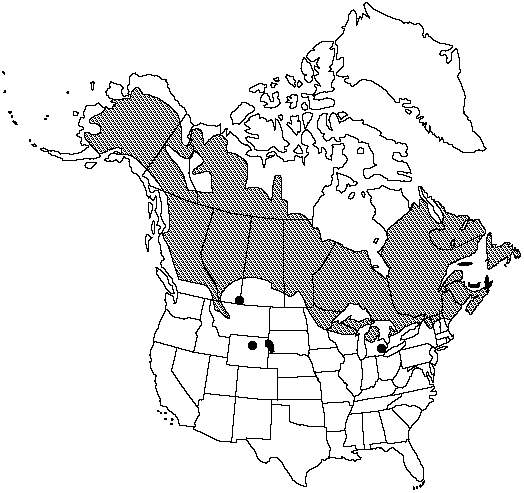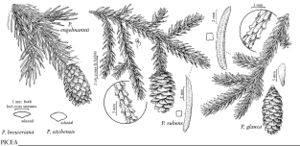Difference between revisions of "Picea glauca"
Mitt. Deutsch. Dendrol. Ges. 16: 93. 1907.
FNA>Volume Importer |
FNA>Volume Importer |
||
| Line 11: | Line 11: | ||
|name=Pinus glauca | |name=Pinus glauca | ||
|authority=Moench | |authority=Moench | ||
| + | |rank=species | ||
|publication_title=Verz. Ausländ. Bäume, | |publication_title=Verz. Ausländ. Bäume, | ||
|publication_place=73. 1785 | |publication_place=73. 1785 | ||
| Line 16: | Line 17: | ||
|name=Picea canadensis | |name=Picea canadensis | ||
|authority=Aiton | |authority=Aiton | ||
| + | |rank=species | ||
|publication_title=Sterns, & Poggenburg | |publication_title=Sterns, & Poggenburg | ||
|publication_place= | |publication_place= | ||
| Line 22: | Line 24: | ||
|name=Abies canadensis | |name=Abies canadensis | ||
|authority=Miller | |authority=Miller | ||
| + | |rank=species | ||
}} {{Treatment/ID/Synonym | }} {{Treatment/ID/Synonym | ||
|name=Picea alba | |name=Picea alba | ||
|authority=(Aiton) Link | |authority=(Aiton) Link | ||
| + | |rank=species | ||
}} {{Treatment/ID/Synonym | }} {{Treatment/ID/Synonym | ||
|name=Picea alba var. albertiana | |name=Picea alba var. albertiana | ||
|authority=(S.Brown) Beissner | |authority=(S.Brown) Beissner | ||
| + | |rank=variety | ||
}} {{Treatment/ID/Synonym | }} {{Treatment/ID/Synonym | ||
|name=Picea albertiana | |name=Picea albertiana | ||
|authority=(Miller) Britton | |authority=(Miller) Britton | ||
| + | |rank=species | ||
}} {{Treatment/ID/Synonym | }} {{Treatment/ID/Synonym | ||
|name=Picea canadensis var. glauca | |name=Picea canadensis var. glauca | ||
|authority=(Moench) Sudworth | |authority=(Moench) Sudworth | ||
| + | |rank=variety | ||
}} {{Treatment/ID/Synonym | }} {{Treatment/ID/Synonym | ||
|name=Picea glauca var. albertiana | |name=Picea glauca var. albertiana | ||
|authority=(S.Brown) Sargent | |authority=(S.Brown) Sargent | ||
| + | |rank=variety | ||
}} {{Treatment/ID/Synonym | }} {{Treatment/ID/Synonym | ||
|name=Picea glauca var. densata | |name=Picea glauca var. densata | ||
|authority=Bailey | |authority=Bailey | ||
| + | |rank=variety | ||
}} {{Treatment/ID/Synonym | }} {{Treatment/ID/Synonym | ||
|name=Picea glauca var. porsildii | |name=Picea glauca var. porsildii | ||
|authority=Raup | |authority=Raup | ||
| + | |rank=variety | ||
}} {{Treatment/ID/Synonym | }} {{Treatment/ID/Synonym | ||
|name=Pinus alba | |name=Pinus alba | ||
| − | |authority= | + | |authority= |
| + | |rank=species | ||
}} | }} | ||
|hierarchy=Pinaceae;Picea;Picea glauca | |hierarchy=Pinaceae;Picea;Picea glauca | ||
| Line 60: | Line 71: | ||
|elevation=0–1000m | |elevation=0–1000m | ||
|distribution=St. Pierre and Miquelon;Alta.;B.C.;Man.;N.B.;Nfld.;N.W.T.;N.S.;Ont.;P.E.I.;Que.;Sask.;Yukon;Alaska;Maine;Mich.;Minn.;Mont.;N.H.;N.Y.;S.Dak.;Vt.;Wis.;Wyo. | |distribution=St. Pierre and Miquelon;Alta.;B.C.;Man.;N.B.;Nfld.;N.W.T.;N.S.;Ont.;P.E.I.;Que.;Sask.;Yukon;Alaska;Maine;Mich.;Minn.;Mont.;N.H.;N.Y.;S.Dak.;Vt.;Wis.;Wyo. | ||
| − | |discussion=<p>In areas of sympatry <i>Picea glauca</i> and <i>P. engelmannii</i> regularly hybridize and intergrade completely (R.Daubenmire 1974; E.H. Garman 1957; K.W. Horton 1959; L.Roche 1969; T.M.C. Taylor 1959). This has greatly complicated the taxonomy of <i>P. glauca</i>, a dominant tree of interior forests of Canada and Alaska. Three varieties have been recognized. <i>Picea glauca</i> var. albertiana was described as having unusually prominent leaf bases, cones nearly as broad as long, cone scales acute and broader than long, and an unusually narrow crown. These are common characteristics of hybrids (e.g., R.Daubenmire 1974). <i>Picea glauca</i> var. porsildii was described as differing from the type variety by having smooth bark with resin blisters, short angular cone scales, an unusually broad crown, and pubescent twigs. These characteristics, also largely intermediate between those of <i>P. glauca</i> < | + | |discussion=<p>In areas of sympatry <i>Picea glauca</i> and <i>P. engelmannii</i> regularly hybridize and intergrade completely (R.Daubenmire 1974; E.H. Garman 1957; K.W. Horton 1959; L.Roche 1969; T.M.C. Taylor 1959). This has greatly complicated the taxonomy of <i>P. glauca</i>, a dominant tree of interior forests of Canada and Alaska. Three varieties have been recognized. <i>Picea glauca</i> var. albertiana was described as having unusually prominent leaf bases, cones nearly as broad as long, cone scales acute and broader than long, and an unusually narrow crown. These are common characteristics of hybrids (e.g., R.Daubenmire 1974). <i>Picea glauca</i> var. porsildii was described as differing from the type variety by having smooth bark with resin blisters, short angular cone scales, an unusually broad crown, and pubescent twigs. These characteristics, also largely intermediate between those of <i>P. glauca</i> <i></i>var.<i> glauca</i> and <i>P. engelmannii</i>, may reflect hybridization where the species overlap. Although the two varieties noted above are reported from well beyond the range of sympatry, the diagnostic characteristics are not well correlated and occur rather sporadically. Also the most distinctive feature of the varieties, the crown shape, is in part responsive to competitive pressures. Because of the problems of hybridization and sporadic occurrence of key characters, <i>P. glauca</i> is treated here in the broad sense.</p><!-- |
--><p><i>Picea glauca</i> (white spruce) is the provincial tree of Manitoba and the state tree (as Black Hills spruce) of South Dakota.</p> | --><p><i>Picea glauca</i> (white spruce) is the provincial tree of Manitoba and the state tree (as Black Hills spruce) of South Dakota.</p> | ||
|tables= | |tables= | ||
| − | |references= | + | |references= |
| − | |||
| − | |||
| − | |||
| − | |||
| − | |||
| − | |||
}}<!-- | }}<!-- | ||
| Line 76: | Line 81: | ||
-->{{#Taxon: | -->{{#Taxon: | ||
name=Picea glauca | name=Picea glauca | ||
| − | |||
|authority=(Moench) Voss | |authority=(Moench) Voss | ||
|rank=species | |rank=species | ||
| Line 86: | Line 90: | ||
|elevation=0–1000m | |elevation=0–1000m | ||
|distribution=St. Pierre and Miquelon;Alta.;B.C.;Man.;N.B.;Nfld.;N.W.T.;N.S.;Ont.;P.E.I.;Que.;Sask.;Yukon;Alaska;Maine;Mich.;Minn.;Mont.;N.H.;N.Y.;S.Dak.;Vt.;Wis.;Wyo. | |distribution=St. Pierre and Miquelon;Alta.;B.C.;Man.;N.B.;Nfld.;N.W.T.;N.S.;Ont.;P.E.I.;Que.;Sask.;Yukon;Alaska;Maine;Mich.;Minn.;Mont.;N.H.;N.Y.;S.Dak.;Vt.;Wis.;Wyo. | ||
| − | |reference= | + | |reference=None |
|publication title=Mitt. Deutsch. Dendrol. Ges. | |publication title=Mitt. Deutsch. Dendrol. Ges. | ||
|publication year=1907 | |publication year=1907 | ||
|special status= | |special status= | ||
| − | |source xml=https://jpend@bitbucket.org/aafc-mbb/fna-data-curation.git/src/ | + | |source xml=https://jpend@bitbucket.org/aafc-mbb/fna-data-curation.git/src/eaa6e58056e40c9ef614d8f47aea294977a1a5e9/coarse_grained_fna_xml/V2/V2_6.xml |
|genus=Picea | |genus=Picea | ||
|species=Picea glauca | |species=Picea glauca | ||
Revision as of 19:49, 16 December 2019
Trees to 30m; trunk to 1m diam.; crown broadly conic to spirelike. Bark gray-brown. Branches slightly drooping; twigs not pendent, rather slender, pinkish brown, glabrous. Buds orange-brown, 3–6mm, apex rounded. Leaves (0.8–)1.5–2(–2.5)cm, 4-angled in cross section, rigid, blue-green, bearing stomates on all surfaces, apex sharp-pointed. Seed cones 2.5–6(–8)cm; scales fan-shaped, broadest near rounded apex, 10–16 × 9–13mm, flexuous, margin at apex ± entire, apex extending 0.5–3mm beyond seed-wing impression. 2n =24.
Habitat: Muskegs, bogs, and river banks to montane slopes
Elevation: 0–1000m
Distribution

St. Pierre and Miquelon, Alta., B.C., Man., N.B., Nfld., N.W.T., N.S., Ont., P.E.I., Que., Sask., Yukon, Alaska, Maine, Mich., Minn., Mont., N.H., N.Y., S.Dak., Vt., Wis., Wyo.
Discussion
In areas of sympatry Picea glauca and P. engelmannii regularly hybridize and intergrade completely (R.Daubenmire 1974; E.H. Garman 1957; K.W. Horton 1959; L.Roche 1969; T.M.C. Taylor 1959). This has greatly complicated the taxonomy of P. glauca, a dominant tree of interior forests of Canada and Alaska. Three varieties have been recognized. Picea glauca var. albertiana was described as having unusually prominent leaf bases, cones nearly as broad as long, cone scales acute and broader than long, and an unusually narrow crown. These are common characteristics of hybrids (e.g., R.Daubenmire 1974). Picea glauca var. porsildii was described as differing from the type variety by having smooth bark with resin blisters, short angular cone scales, an unusually broad crown, and pubescent twigs. These characteristics, also largely intermediate between those of P. glauca var. glauca and P. engelmannii, may reflect hybridization where the species overlap. Although the two varieties noted above are reported from well beyond the range of sympatry, the diagnostic characteristics are not well correlated and occur rather sporadically. Also the most distinctive feature of the varieties, the crown shape, is in part responsive to competitive pressures. Because of the problems of hybridization and sporadic occurrence of key characters, P. glauca is treated here in the broad sense.
Picea glauca (white spruce) is the provincial tree of Manitoba and the state tree (as Black Hills spruce) of South Dakota.
Selected References
None.
